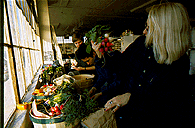
- Check out Other Hints For Greener Living
From Boston to San Francisco, investors are sinking their teeth into a new high-growth venture. Providing seed money is what it’s about, and those who take stock are rewarded with plenty of green. Want in?
Well, don’t start scouring Nasdaq for clues. These shares are traded in an exchange of a different sort. Called Community Supported Agriculture (CSA), it’s an arrangement in which consumers bankroll a small farm and get fresh organic fruits and vegetables in return. CSA may be the only investment plan where eating the profits is encouraged.
Here’s the fine print: Farmers (some growing on as little as one acre) sell shares in their farms to subscribers, often city dwellers, at the beginning of the growing season. Then, once a week, the “investors” receive fresh produce from the farm. The cost varies depending on the farm and the length of the growing season. In California, for example, some programs operate year-round; on the East Coast, they usually run for about six months.
At the 35-acre Rose Valley Farm in Rose, New York, subscribers pay from $200 to $375 for a 25-week season. And — get this — they also have to put in 16 hours of labor per season. “We started with 29 families who were interested in trying CSA as an experiment,” says Elizabeth Henderson, who started the program eight years ago. “At the end of the season, when we evaluated it, people had enjoyed the farmwork just as much as the food. So, we kept that as a basic requirement.”
The CSA concept is a product of the turbulent ’60s — in Japan. As the country faced a loss of farmland due to development, a growing infiltration of imported foods, and the resulting exodus of farmers to cities, a group of Japanese homemakers approached a local farmer with the idea of making a financial commitment to the farm in exchange for fruits and vegetables. They entered into a contract, or teikei, which literally translates as “partnership,” but philosophically means “food with the farmer’s face on it.” The concept took root and eventually spread.
Back in the United States, the only face families were seeing on their food was that of the Green Giant. Until 1985, that is, when the first American teikei, or CSA, began at Indian Line Farm in Great Barrington, Massachusetts. Today, more than 600 CSA farms across the U.S. and Canada serve close to 150,000 participants, according to CSA of North America, also based at Indian Line Farm.
Just what do subscribers get? Invariably, more food than they can stomach. On any given week in October, for example, members of Rose Valley Farm receive a half-bushel basket that might include spinach, lettuce, turnip greens, red and green cabbage, cilantro, bok choy, beets, kale, carrots, mustard greens, kohlrabi, daikon, broccoli, cauliflower, winter squash, potatoes, pumpkins, parsnips, or rutabagas. “It almost forces you to eat better so nothing goes to waste,” says Carol Moldt, who has been a member for seven years.
CSA does have risks. If the harvest you’ve invested in is bountiful, your kitchen will be the lucky recipient of fragrant fruits and vegetables harvested the day before. But, given a drought or flooding, or a pesky insect tucked into your share, it may turn out to be a veritable stinker. Either way, you’ve bought the farm.
While most CSA members hope for a continuous supply of produce, it’s not the only reason they sign on. There’s also the satisfaction of helping a small, local farm survive.
“Nobody’s getting rich doing this,” says Robyn Van En, co-founder of the at Indian Line Farm. “But with CSA, committing for the year guarantees that, come hell or high water, the farmer will be there.” And that’s important, unless you prefer that tall guy in the green tights.
















